| Ireland (Éire). Wincor Nixdorf issues |
|
 |
| 2008. The pilot with the Wincor Nixdorf postal kiosks |
An Post -the Irish postal administration- started on July 21st 2008, and, as an almost unnoticed extra, ran a pilot scheme using two ProPostal 2000 postal kiosks, manufactured by the Portuguese company NewVision and distributed by the multinational Wincor Nixdorf. The machines were installed in both the Dublin main post office and the airport.
These self-service postal kiosks have similar characteristics and features to those already in service in The Netherlands and Austria, although in this case they have been customized with the green colour and graphic design of An Post.
Unfortunately, at the time for writing this article, we have very little information about this subject, due to the "secrecy" surrounding the activities by all parties involved. The start of the test was a complete disaster. The postal kiosk, installed in the Dublin GPO, broke down many times on July 21st - the first day, and despite the continuous intervention by the maintenance technician, it was definitely taken out of service before 5 pm. Both this machine and the one that was claimed to have been installed at the airport, were removed from their locations on the next day, for repair work, and the date for their re-installation is still unknown.
An Post plan the installation of 4 further postal kiosks in other locations, yet to be announced and, depending on the success of the pilot scheme (!! ??), they could rollout the machines nationwide.
For the issue in the postal kiosks, An Post prepared a series of 4 self-adhesive labels dedicated to the Irish inland waterways. The design is by Steve Simpson, from photographs by Walter Pfeiffer, identical to those used in the series of commemorative 'traditional' stamps issued on October 20th 2006.
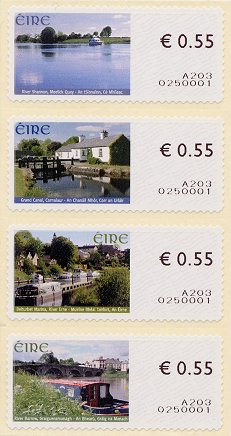 |
 |
The network of Irish inland waterways, originally conceived for inland transport, is composed of a large network of interconnected waterways, lakes and rivers. Today they are mainly dedicated to leisure activities.
The River Shannon in Meelick Pier, at County Galway.
The river runs 344 km from its source on the slopes of Cuilcagh Mountain to its mouth on the Atlantic Ocean.
The Grand Canal in Cornalaur, at County Offaly.
The navigation on the Grand Canal was one of the main transport routes across Ireland. It runs between Ringsend, in Dublin, and Shannon Harbour, in County Offaly.
Belturbet Marina on the River Erne, at County Cavan.
The network includes various Erne waterways, in addition to the River Erne.
Barrow Navigation in Graignamanagh, at County Kilkenny.
The waterway its 120 km. long and links the cities of Waterford and Dublin. The construction began in 1761 and contains 32 locks. |
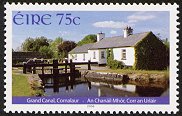 |
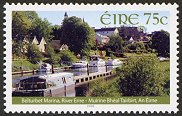 |
 |
The manufacturer of the rolls is a local company - Label Art. The self-adhesive labels are sized 56 x 25 mm on a waxed backing paper of 60 mm length, and have a horizontal serration between the labels. The labels have perforations around the perimeter - as in 'traditional' stamps - and a phosphorescent perimeter strip. The 4 designs appear in a continuous pattern on the rolls. The postal kiosks print the face value and other data by thermal printing on the right hand half of the labels. Both the characteristics of the labels and the printing made by the machines are reminiscent of the aCon issues in Norway or Denmark.
In addition to the face value, other information is also printed on the right hand half of the labels, in 2 lines. On the top line, the date of issue of the stamps uses a very unusual system. For example, the first day of issue, July 21st 2008 is A203, where A is the first year of issue - 2008, and 203 is the number of the day in that year, with January 1st as day 1. In the bottom line, the machine reference number is divided into 2 parts: the first 4 digits correspond to the issuing office (0250, in the image above, is the philatelic service, in Dublin) and the last 3 digits are the unique machine identification number (001 in the image).
| The image on the right corresponds to the detail of a (rare) first day cover franked with variable value stamps issued on the first day (A203), by the postal kiosk installed in the Dublin GPO. As can be seen in the second line, the code is 9801001 and not 0250001. |
 |
Official first day cover.
The Philatelic Service prepared illustrated first day covers, franked with the 4 new designs with the basic inland postage rate (0.55 EUR), and the commemorative postmark. |
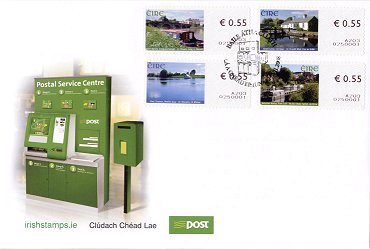 |
| The roll out of the Wincor Nixdorf self-service postal kiosks |
After resolving the problems which arose during the early days of the pilot test -typical and not unexpected for these pilot trials-, An Post started the progressive rollout of the new ProPostal 2000 self-service postal kiosks throughout the country (see article above >, also published in VARIABLE 10).
| With the exception of one machine, installed in the Dublin main post office, all postal self-service units are installed in large commercial areas and shopping centres in major cities, plus other public and private buildings such as the Dublin International Airport, St. James Hospital, business parks, and even the University of Cork. One of the postal kiosks is even installed in a small store in downtown Dublin - Centra in Temple Bar (see brochure below, and images and locations list at the end of the article). In short, locations are used which have large numbers of visitors and extended opening hours, and where users can buy stamps (ATMs) or arrange for the basic franking and mailing operations of letters and packages, in a relaxed way, and with no need to approach a post office. |
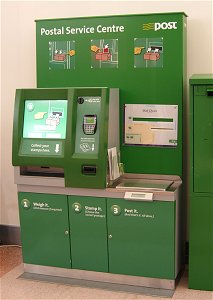 |
| Brochure of the Postal Service Centre installed in the Centra supermarket, in the Dublin Temple Bar area. |
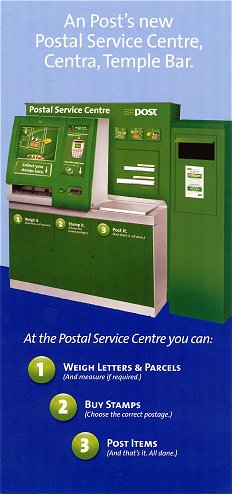 |
 |
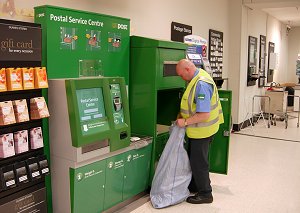 |
The basic unit of the self-service postal kiosk (called Postal Service Centre), is customized with the An Post colour and logo. It is made up of the ProPostal 2000 postal kiosk, a back panel with information on the process of postage and mailing, and a large mailbox on one side for franked postal items, which are collected once daily. |
| The operation of the Irish Propostal 2000 postal kiosks is very simple. Through a touch screen (see screen shot sequence below), the user can choose between three languages: English, Irish or ... Polish (!). (The last option might surprise you, but we must bear in mind that after Poland entered the European Union in 2004, thousands of Polish workers emigrated to Ireland, and currently Polish is the largest minority language in the country). Then, the user can choose between 'Weigh Item' or 'Buy Stamps'. With the first option, the customer places the letter or packet on the scale at the side and, after selecting the postal item type from the four options available, and the country of destination, the system indicates the required postage. With the option 'Buy Stamps', the postal kiosk offers four basic postal rates only. At the time of writing this article there are two for domestic mail, 0.55 and 0.95 EUR -the tariff for letters up to 100 g. and maximum sizes C4 and C5, respectively-, and two for international mail, 0.82 and 1.50 EUR, -weighing up to 100 g. and maximum size C4 and C5-. It is possible to buy different stamps in one operation. Payment (right picture) can be done with coins, banknotes and, if the total amount is above 5 EUR, with bank cards. |
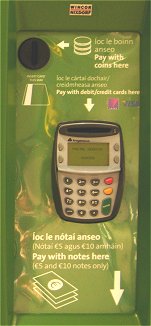 |
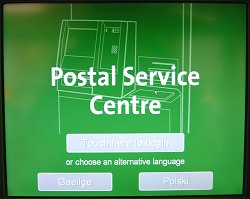 |
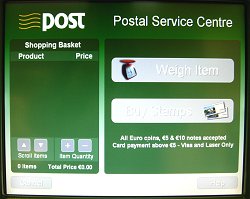 |
Left picture, main screen, language selection.
Right, the user can choose between the weighing the postal piece (Weigh Item) or the purchase of stamps (Buy Stamps). |
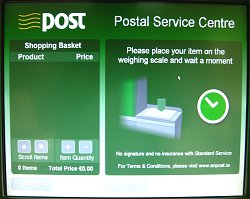 |
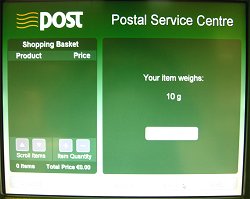 |
With the weighing option, the system requests the placement of the letter or packet on the side scale, and then displays the weight in grams. |
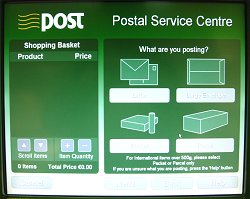 |
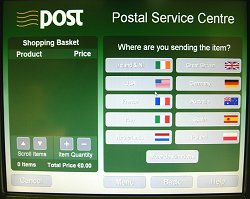 |
After weighing, the user selects the type of letter or packet, and also the country of destination. |
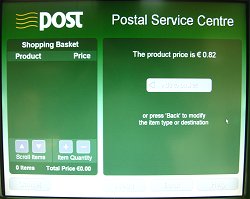 |
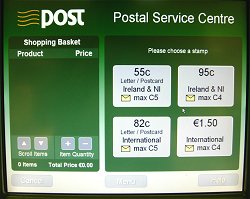 |
Left picture. At the end of the previous operations, the system indicates the correct postage.
Right picture. Screen showing the four basic postage values when selecting the 'Buy Stamps' option. |
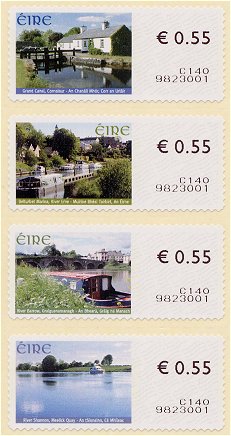 |
Regarding the rolls of self-adhesive labels used by the postal kiosks for the ATMs imprint and issue, it is possible to recognize two main varieties of the first design - the series dedicated to the Irish inland waterways (see article above >, also published in VARIABLE 10):
- In the first edition, self-adhesive labels feature a phosphorescent perimeter frame. These were used only during the first day (July 21st 2008) in test kiosk number 9801001 installed in the Dublin main post office, and also by the philatelic service for the preparation of the first-day philatelic material (ATMs dated A203 and machine number 0250001).
- New rolls of labels were used in all postal kiosks from October 2008, with the same design and features, but the new labels only include three vertical phosphorescent strips, on both edges of the design and the right edge of the label. At least two editions have been manufactured with these characteristics, with small differences.
There are ATMs of this variety with the first day date (A203) and the machine number 0250001, issued months later for the philatelic service when the material prepared initially was sold out (strips of 4 ATMs - 4 x 0.55 EUR, and first day covers as well). |
 |
1st. variety
Phosphorescent edge frame |
2nd. variety
Three vertical phosphorescent strips |
As explained in the previous article, the face value, the date of issue and the reference number are printed on the right of the labels.
- The special format of the date includes a letter for the year (A is the first year of issue for postal kiosks, 2008), and a figure indicating the number of days in that year (with January 1st as day 1). For example, the date of the four ATMs above -C140-, corresponds to the third year - 2010, and day 140 in that year - May 20th.
- The reference code includes a 4-digits block indicating the postal kiosk location (9823 in the picture above - the Liffey Valley Shopping Centre in Dublin - see list at end of article) and three further numbers corresponding to the machine number group in that location (for the moment, all numbers are 001 because only a single kiosk is installed at each location).
After the sale, the ProPostal 2000 postal kiosk offers the option of a receipt, in English or Gaelic, printed on thermal paper.
The first image corresponds to a receipt in Irish for the purchase of the 4 ATM strip, above, issued by the 9823001 machine.
The central picture is a receipt in English issued by postal kiosk 9801001, located in the Dublin main post office, for the purchase of four ATMs with the four values available, which make up the basic set.
When the roll of labels has run out, or the machine cannot issue the required stamps, or return any change, it automatically issues an ERROR RECEIPT - right image. This special receipt shows the total to be returned and the postal address where the customer must send the receipt for a refund, by mail. (Payment is by cheque, and takes 3-4 weeks after being sent). |
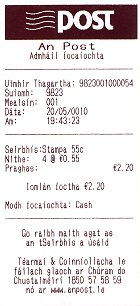 |
 |
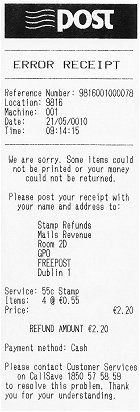 |
| Test imprint on paper receipt automatically issued by the postal kiosk. |
 |
| Some pictures of the Postal Service Centres in Ireland ... |
 |
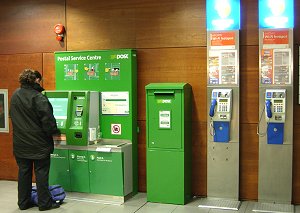 |
| 9801001 - Dublin main post office |
9802001 - Dublin Airport |
 |
 |
| 9803001 - Blanchardstown Shopping Centre, Dublin |
9804001 - Square Tallaght, Dublin |
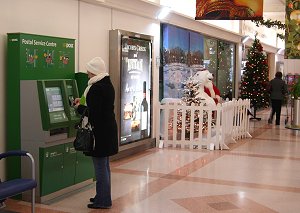 |
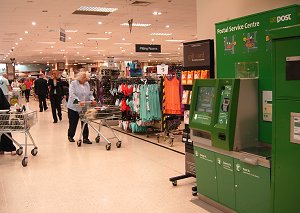 |
| 9805001 - Tesco Merrion, Dublin |
9809001 - Dunnes Stores Cornelscourt, Dublin |
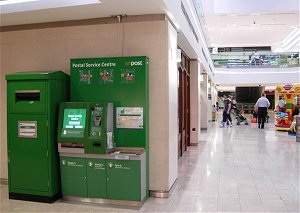 |
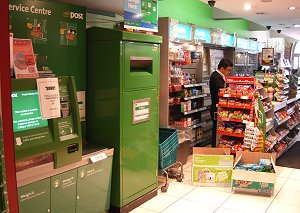 |
| 9810001 - Dun Laoghaire Shopping Centre, Dublin |
9814001 - Centra Temple Bar, Dublin |
 |
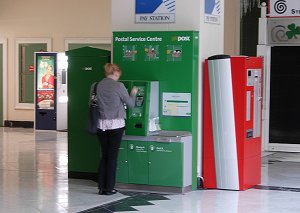 |
| 9816001 - St. James's Hospital, Dublin |
9821001 - St. Stephens Green Shopping Centre, Dublin |
Machine
number |
Postal Service Centre location |
Go-live
date |
| 9801001 |
Dublin main post office |
21.07.2008
27.08.2009 |
4567123 (Oct. 08)
9802001 |
Dublin airport |
06.10.2008 |
| 9803001 |
Blanchardstown Shopping Centre, Dublin |
04.11.2008 |
| 9804001 |
Square Tallaght, Dublin |
17.10.2008 |
| 9805001 |
Tesco Merrion, Dublin |
22.10.2008 |
| 9806001 |
Tesco Greystones |
17.11.2008 |
| 9807001 |
Dunnes Stores, Cork |
03.09.2009 |
| 9808001 |
University College Cork |
02.07.2009 |
| 9809001 |
Dunnes Stores Cornelscourt, Dublin |
29.07.2009 |
| 9810001 |
Dun Laoghaire Shopping Centre, Dublin |
29.07.2009 |
| 9811001 |
Waterford IT, Waterford |
30.07.2009 |
| 9812001 |
Scotch Hall Shopping Centre, Drogheda |
04.08.2009 |
| 9813001 |
Marshes Shopping Centre, Dundalk Co. Louth |
04.08.2009 |
| 9814001 |
Centra Temple Bar, Dublin |
14.09.2009 |
| 9815001 |
Charlestown Shopping Centre, Dublin |
11.08.2009 |
| 9816001 |
James' Hospital, Dublin |
13.08.2009 |
| 9817001 |
Ebay - Atrium Building, Blanchardstown, Dublin |
06.08.2009 |
| 9818001 |
Tesco Shopping Centre, Sligo |
19.08.2009 |
| 9819001 |
Tesco Shopping Centre, Ennis, Co Clare |
19.08.2009 |
| 9820001 |
Pavilions Shopping Centre, County Dublin |
09.09.2009 |
| 9821001 |
St. Stephens Green Shopping Centre, Dublin |
26.10.2009 |
| 9822001 |
Jervis Shopping Centre, Dublin |
10.12.2009 |
| 9823001 |
Liffey Valley Shopping Centre, Dublin |
17.12.2009 |
| 9824001 |
Mahon Point Shopping Centre, Mahon |
10.03.2010 |
| 9825001 |
Fairgreen Shopping Centre, Co, Carlow |
17.05.2010 |
| 9826001 |
Arthurs Quay Shopping Centre, Limerick |
18.02.2010 |
| 9827001 |
City Square Shopping Centre, Waterford |
02.02.2010 |
| 9828001 |
MacDonagh Junction Shopping Centre, Co, Kilkenny |
21.01.2010 |
| 9829001 |
Eyre Square Shopping Centre, Galway |
11.03.2010 |
| 9830001 |
Supervalu Middleton, Co. Cork |
24.02.2010 |
| 9831001 |
Eastpoint Business Park, Dublin |
15.04.2010 |
| 9832001 |
Bridgewater Arklow, County Wicklow |
08.04.2010 |
| 9833001 |
Manor West Tralee, County Kerry |
22.04.2010 |
| (Updated list at June 9th 2010) |
| The basic postal tariffs in Ireland (2008 - ...) |
Standardized letters
up to 50 g. |
Ireland and North Ireland |
Great Britain |
Europe |
Rest of the world |
| Standard |
Standard |
Standard |
Standard |
| 3.3.2008 |
0.55 |
0.82 |
0.82 |
0.82 |
ATM Web - Spain and Latin American Postal Services: http://www.ateeme.net
© J. Jove - M. Sans. ATEEME. Variable value stamps study group. All rights reserved
This page was created in August 2008 and last updated:
27.06.10
. English edition rewritten by S. Goodman (26.06.10)
|



































